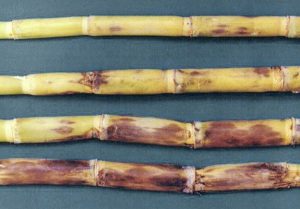- The red rot is a very known disease in sugarcane.
- Sugarcane is a major agricultural crop worldwide. India is the largest consumer and the second-largest producer of sugar and the production of sugarcane plays a vital role. But diseases affecting sugarcane are a major concern for the low yield.
- It is also known as the cancer of sugarcane.
- It is caused by Colletotrichum falcatum Went.
- It was recognised as a disease in Java by Went in 1893

Organism Involved
Red rot of sugarcane is caused by Colletotrichum falcatum Went
Systematic Position
Division: Eumycota
Subdivision: Deuteromycotina
Class: Coelomycetes
Order: Melanconiales
Family: Melanconiaceae
Genus: Colletotrichum
Species: falcatum
Class: Coelomycetes
Order: Melanconiales
Family: Melanconiaceae
Genus: Colletotrichum
Species: falcatum
- The common name of the disease is called Red Smut
- C. falcatum is a facultative saprophyte.
- It is a toxic producing fungi.
- It’s sexual stage is known as Glomerella. tucumanensis is responsible for the survival of the fungus on decaying leaves and formation of new virulent pathological diseases.
Distribution
-
The major sugarcane producing countries are Brazil, India, United States of America , Australia, Thailand, Pakistan, China and Mexico,
Mode of Infection
- The pathogen mainly infects canes through nodes and the main portal of entry are leaf scar, growth ring, root primordia and buds.
- The disease attacks the sugarcane at the stalks, stubble rhizomes, and leaf midrib. It may even extend to leaf-blade and leaf-sheath tissues and is capable of infecting sugarcane roots.
Symptoms of Red Rot Of Sugarcane
- Red rot can only be observed when it has been completely rotted in the interior and lose its natural bright colour and become dull.
- Plants can be seen yellowing, shrivelling, and dying of the upper leaves.
- The disease can be recognized by the longitudinal reddening of the normally white or
yellowish-white internal tissues of the internode - The lesions on the leaf midribs can be seen as dark reddish areas which may elongate and reach the entire leaf.
- The young lesions are blood red in colour with darker margins.
- The centers start fading and become straw-coloured with age, and when fructification of the fungus begins, the lesions are covered with black powdery masses of conidia.
Favourable conditions for the cause of the disease
- It was considered that bad cultivation and poor drainage favour the cause of the disease
- Environmental conditions in subtropical countries favour the disease.
- Mean temperature range of 29.4 to 31°C
- High atmospheric humidity
Losses Caused
- The disease causes a stiff drop by reducing the crop stands and by reducing the sucrose content of the cane juice.
- Additional to the sucrose reduction in internodes, the joints above the diseased positions were also affected.
- Decreased juice extraction, percentage of solids and sucrose in the juice, purity and chemical changes were observed.

Disease Control
- The control of the diseases depends upon weather conditions, genotypes, presence of virulent
pathogen and time for disease development. - It is impossible to control the disease once it appears on the field.
- The direct focus can be in prophylactic measures to reduce pathogen build up in the field
- Integrated Disease Management (IDM) can be followed.
- Resistance varieties can be grown which is an efficient alternative against such huge losses.
-
Good cultural practices, using disease-free planting materials, physical, biologic and chemical control may aid to the control of diseases
-
Sustainable alternative including Bio-control agents can be used for the control.
References
- https://www.researchgate.net/publication/343896734_Current_and_Prospective_Strategies_on_Detecting_and_Managing_Colletotrichumfalcatum_Causing_Red_Rot_of_Sugarcane
- https://naldc.nal.usda.gov/download/CAT86200636/PDF
- https://www.researchgate.net/publication/333194052_A_Review_on_Red_Rot_The_Cancer_of_Sugarcane#pf2